Analysis of SCP's Investment Property Valuation and Retail Impact
VerifiedAdded on 2023/03/23
|9
|2187
|63
Report
AI Summary
This report evaluates Shopping Centres Australia Property Group's (SCP) approach to valuing its property, focusing on management's flexibility in investment property valuation. It examines the impact of changes in the retail industry on SCP's financial performance, including the ability to expand investments and the effects of new lease accounting standards on key performance metrics like EBIT, EBITDA, PBT, and debt-to-equity ratio. The report also addresses the economic effects of these changes, such as slower wage growth, online shopping shifts, and decreased profit margins due to increased competition, while considering the implications of AASB 121 on foreign exchange.
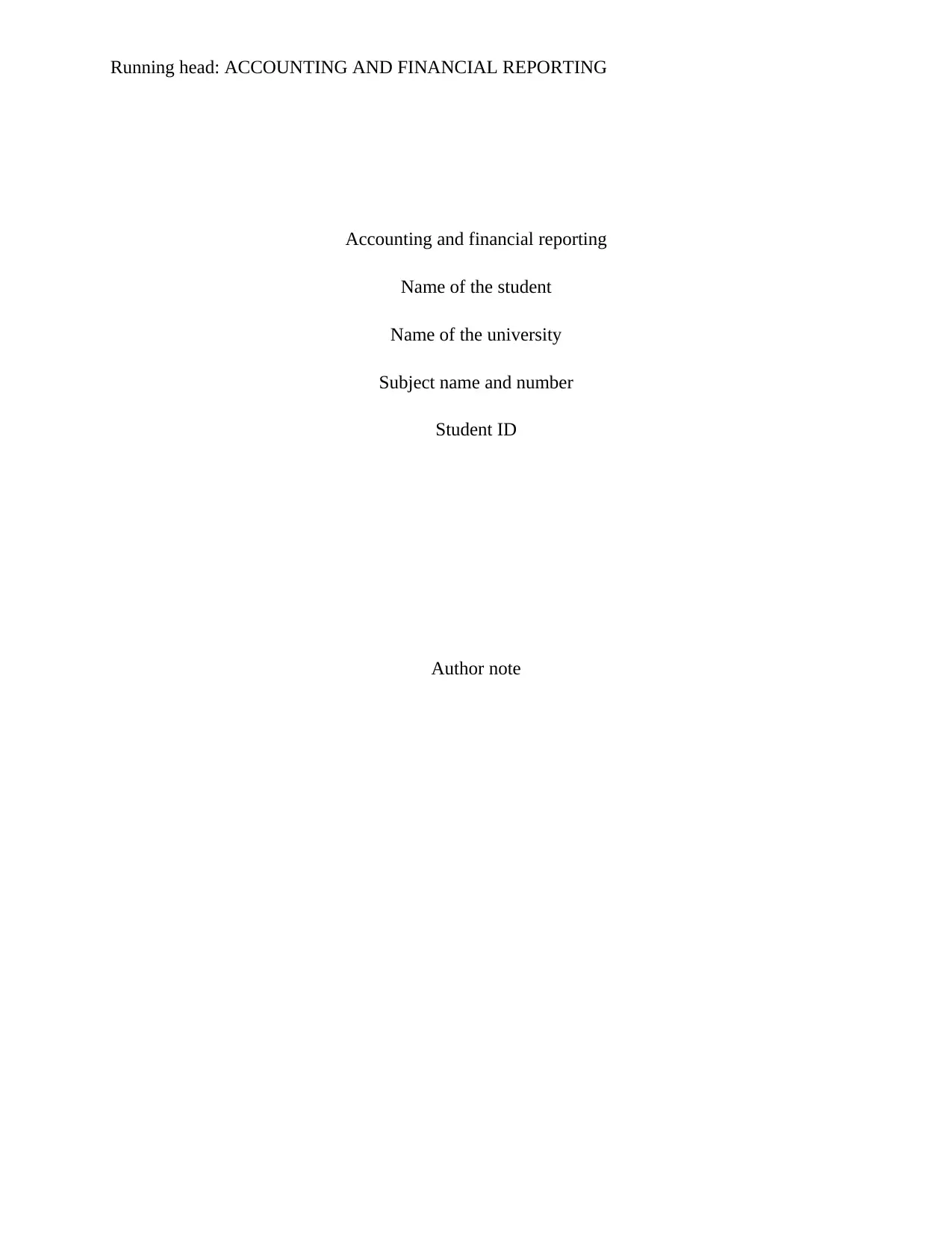
Running head: ACCOUNTING AND FINANCIAL REPORTING
Accounting and financial reporting
Name of the student
Name of the university
Subject name and number
Student ID
Author note
Accounting and financial reporting
Name of the student
Name of the university
Subject name and number
Student ID
Author note
Paraphrase This Document
Need a fresh take? Get an instant paraphrase of this document with our AI Paraphraser
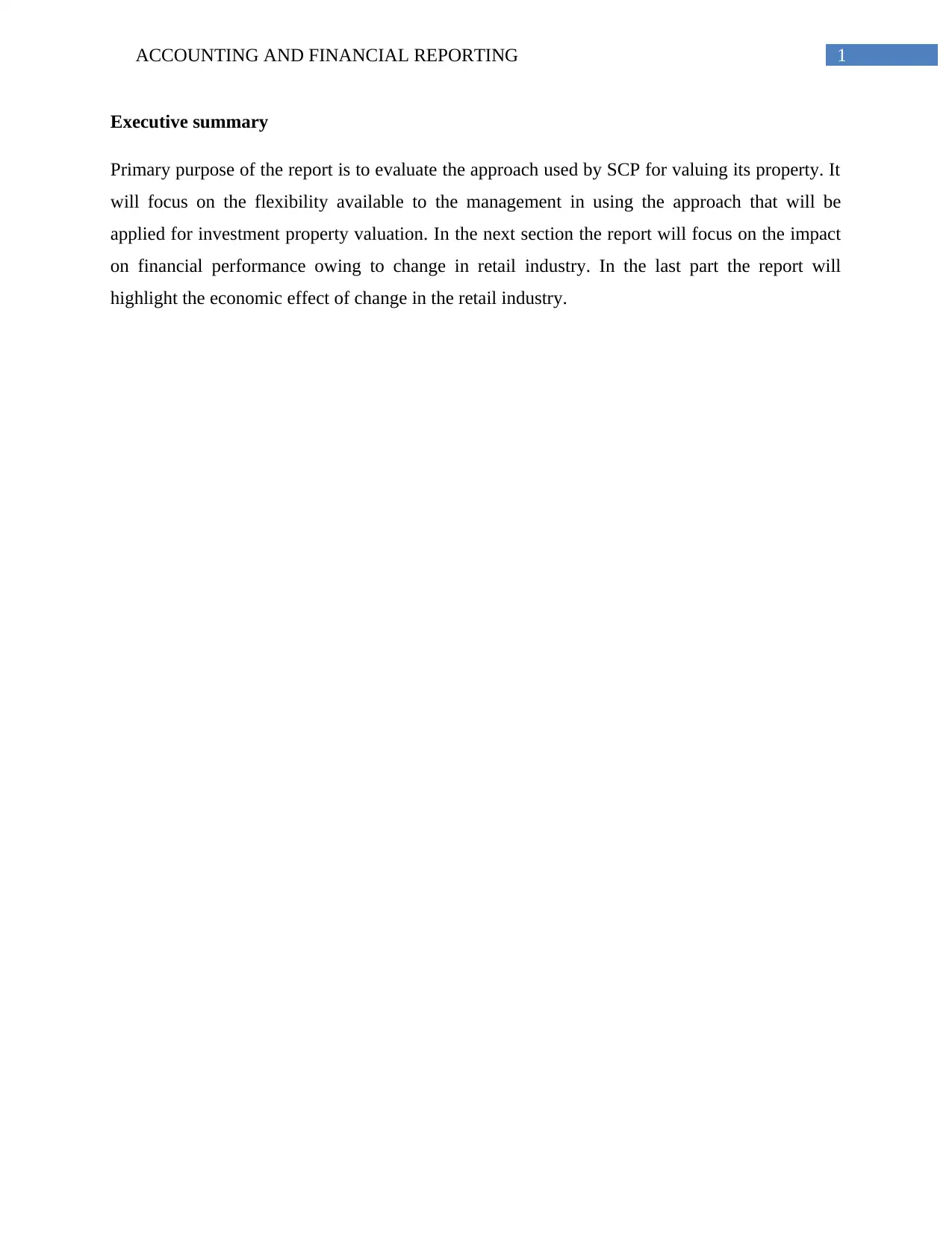
1ACCOUNTING AND FINANCIAL REPORTING
Executive summary
Primary purpose of the report is to evaluate the approach used by SCP for valuing its property. It
will focus on the flexibility available to the management in using the approach that will be
applied for investment property valuation. In the next section the report will focus on the impact
on financial performance owing to change in retail industry. In the last part the report will
highlight the economic effect of change in the retail industry.
Executive summary
Primary purpose of the report is to evaluate the approach used by SCP for valuing its property. It
will focus on the flexibility available to the management in using the approach that will be
applied for investment property valuation. In the next section the report will focus on the impact
on financial performance owing to change in retail industry. In the last part the report will
highlight the economic effect of change in the retail industry.
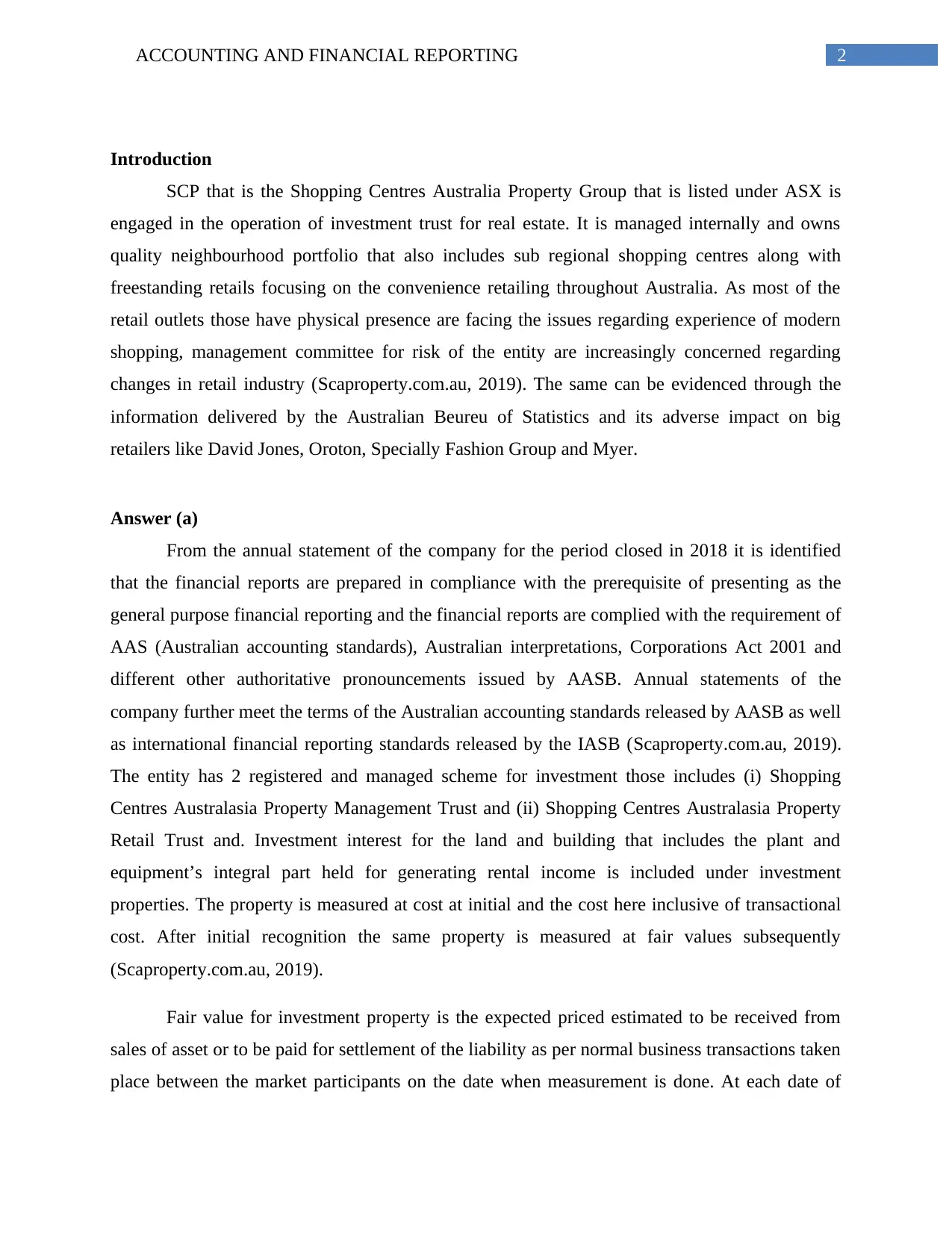
2ACCOUNTING AND FINANCIAL REPORTING
Introduction
SCP that is the Shopping Centres Australia Property Group that is listed under ASX is
engaged in the operation of investment trust for real estate. It is managed internally and owns
quality neighbourhood portfolio that also includes sub regional shopping centres along with
freestanding retails focusing on the convenience retailing throughout Australia. As most of the
retail outlets those have physical presence are facing the issues regarding experience of modern
shopping, management committee for risk of the entity are increasingly concerned regarding
changes in retail industry (Scaproperty.com.au, 2019). The same can be evidenced through the
information delivered by the Australian Beureu of Statistics and its adverse impact on big
retailers like David Jones, Oroton, Specially Fashion Group and Myer.
Answer (a)
From the annual statement of the company for the period closed in 2018 it is identified
that the financial reports are prepared in compliance with the prerequisite of presenting as the
general purpose financial reporting and the financial reports are complied with the requirement of
AAS (Australian accounting standards), Australian interpretations, Corporations Act 2001 and
different other authoritative pronouncements issued by AASB. Annual statements of the
company further meet the terms of the Australian accounting standards released by AASB as well
as international financial reporting standards released by the IASB (Scaproperty.com.au, 2019).
The entity has 2 registered and managed scheme for investment those includes (i) Shopping
Centres Australasia Property Management Trust and (ii) Shopping Centres Australasia Property
Retail Trust and. Investment interest for the land and building that includes the plant and
equipment’s integral part held for generating rental income is included under investment
properties. The property is measured at cost at initial and the cost here inclusive of transactional
cost. After initial recognition the same property is measured at fair values subsequently
(Scaproperty.com.au, 2019).
Fair value for investment property is the expected priced estimated to be received from
sales of asset or to be paid for settlement of the liability as per normal business transactions taken
place between the market participants on the date when measurement is done. At each date of
Introduction
SCP that is the Shopping Centres Australia Property Group that is listed under ASX is
engaged in the operation of investment trust for real estate. It is managed internally and owns
quality neighbourhood portfolio that also includes sub regional shopping centres along with
freestanding retails focusing on the convenience retailing throughout Australia. As most of the
retail outlets those have physical presence are facing the issues regarding experience of modern
shopping, management committee for risk of the entity are increasingly concerned regarding
changes in retail industry (Scaproperty.com.au, 2019). The same can be evidenced through the
information delivered by the Australian Beureu of Statistics and its adverse impact on big
retailers like David Jones, Oroton, Specially Fashion Group and Myer.
Answer (a)
From the annual statement of the company for the period closed in 2018 it is identified
that the financial reports are prepared in compliance with the prerequisite of presenting as the
general purpose financial reporting and the financial reports are complied with the requirement of
AAS (Australian accounting standards), Australian interpretations, Corporations Act 2001 and
different other authoritative pronouncements issued by AASB. Annual statements of the
company further meet the terms of the Australian accounting standards released by AASB as well
as international financial reporting standards released by the IASB (Scaproperty.com.au, 2019).
The entity has 2 registered and managed scheme for investment those includes (i) Shopping
Centres Australasia Property Management Trust and (ii) Shopping Centres Australasia Property
Retail Trust and. Investment interest for the land and building that includes the plant and
equipment’s integral part held for generating rental income is included under investment
properties. The property is measured at cost at initial and the cost here inclusive of transactional
cost. After initial recognition the same property is measured at fair values subsequently
(Scaproperty.com.au, 2019).
Fair value for investment property is the expected priced estimated to be received from
sales of asset or to be paid for settlement of the liability as per normal business transactions taken
place between the market participants on the date when measurement is done. At each date of
⊘ This is a preview!⊘
Do you want full access?
Subscribe today to unlock all pages.

Trusted by 1+ million students worldwide
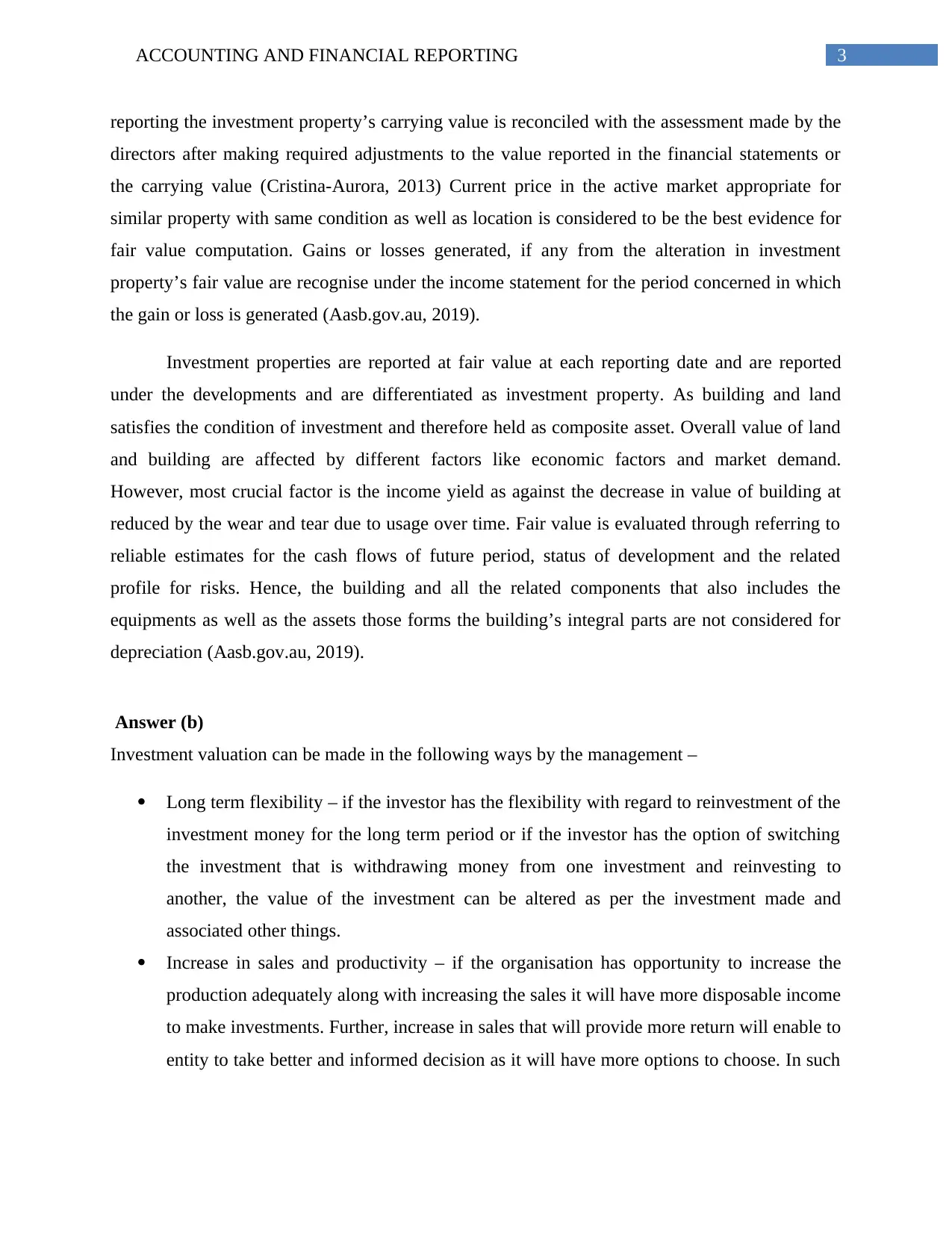
3ACCOUNTING AND FINANCIAL REPORTING
reporting the investment property’s carrying value is reconciled with the assessment made by the
directors after making required adjustments to the value reported in the financial statements or
the carrying value (Cristina-Aurora, 2013) Current price in the active market appropriate for
similar property with same condition as well as location is considered to be the best evidence for
fair value computation. Gains or losses generated, if any from the alteration in investment
property’s fair value are recognise under the income statement for the period concerned in which
the gain or loss is generated (Aasb.gov.au, 2019).
Investment properties are reported at fair value at each reporting date and are reported
under the developments and are differentiated as investment property. As building and land
satisfies the condition of investment and therefore held as composite asset. Overall value of land
and building are affected by different factors like economic factors and market demand.
However, most crucial factor is the income yield as against the decrease in value of building at
reduced by the wear and tear due to usage over time. Fair value is evaluated through referring to
reliable estimates for the cash flows of future period, status of development and the related
profile for risks. Hence, the building and all the related components that also includes the
equipments as well as the assets those forms the building’s integral parts are not considered for
depreciation (Aasb.gov.au, 2019).
Answer (b)
Investment valuation can be made in the following ways by the management –
Long term flexibility – if the investor has the flexibility with regard to reinvestment of the
investment money for the long term period or if the investor has the option of switching
the investment that is withdrawing money from one investment and reinvesting to
another, the value of the investment can be altered as per the investment made and
associated other things.
Increase in sales and productivity – if the organisation has opportunity to increase the
production adequately along with increasing the sales it will have more disposable income
to make investments. Further, increase in sales that will provide more return will enable to
entity to take better and informed decision as it will have more options to choose. In such
reporting the investment property’s carrying value is reconciled with the assessment made by the
directors after making required adjustments to the value reported in the financial statements or
the carrying value (Cristina-Aurora, 2013) Current price in the active market appropriate for
similar property with same condition as well as location is considered to be the best evidence for
fair value computation. Gains or losses generated, if any from the alteration in investment
property’s fair value are recognise under the income statement for the period concerned in which
the gain or loss is generated (Aasb.gov.au, 2019).
Investment properties are reported at fair value at each reporting date and are reported
under the developments and are differentiated as investment property. As building and land
satisfies the condition of investment and therefore held as composite asset. Overall value of land
and building are affected by different factors like economic factors and market demand.
However, most crucial factor is the income yield as against the decrease in value of building at
reduced by the wear and tear due to usage over time. Fair value is evaluated through referring to
reliable estimates for the cash flows of future period, status of development and the related
profile for risks. Hence, the building and all the related components that also includes the
equipments as well as the assets those forms the building’s integral parts are not considered for
depreciation (Aasb.gov.au, 2019).
Answer (b)
Investment valuation can be made in the following ways by the management –
Long term flexibility – if the investor has the flexibility with regard to reinvestment of the
investment money for the long term period or if the investor has the option of switching
the investment that is withdrawing money from one investment and reinvesting to
another, the value of the investment can be altered as per the investment made and
associated other things.
Increase in sales and productivity – if the organisation has opportunity to increase the
production adequately along with increasing the sales it will have more disposable income
to make investments. Further, increase in sales that will provide more return will enable to
entity to take better and informed decision as it will have more options to choose. In such
Paraphrase This Document
Need a fresh take? Get an instant paraphrase of this document with our AI Paraphraser
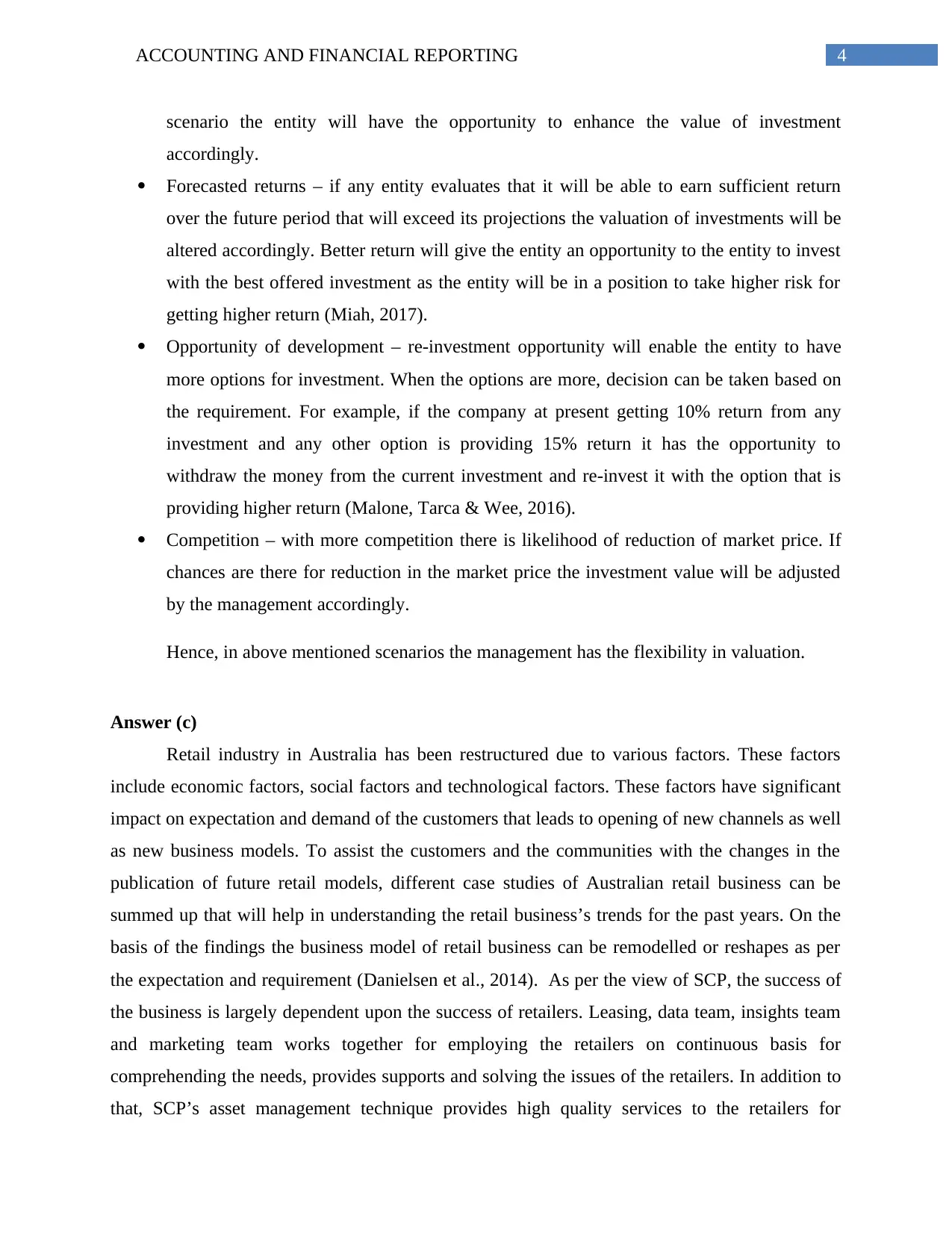
4ACCOUNTING AND FINANCIAL REPORTING
scenario the entity will have the opportunity to enhance the value of investment
accordingly.
Forecasted returns – if any entity evaluates that it will be able to earn sufficient return
over the future period that will exceed its projections the valuation of investments will be
altered accordingly. Better return will give the entity an opportunity to the entity to invest
with the best offered investment as the entity will be in a position to take higher risk for
getting higher return (Miah, 2017).
Opportunity of development – re-investment opportunity will enable the entity to have
more options for investment. When the options are more, decision can be taken based on
the requirement. For example, if the company at present getting 10% return from any
investment and any other option is providing 15% return it has the opportunity to
withdraw the money from the current investment and re-invest it with the option that is
providing higher return (Malone, Tarca & Wee, 2016).
Competition – with more competition there is likelihood of reduction of market price. If
chances are there for reduction in the market price the investment value will be adjusted
by the management accordingly.
Hence, in above mentioned scenarios the management has the flexibility in valuation.
Answer (c)
Retail industry in Australia has been restructured due to various factors. These factors
include economic factors, social factors and technological factors. These factors have significant
impact on expectation and demand of the customers that leads to opening of new channels as well
as new business models. To assist the customers and the communities with the changes in the
publication of future retail models, different case studies of Australian retail business can be
summed up that will help in understanding the retail business’s trends for the past years. On the
basis of the findings the business model of retail business can be remodelled or reshapes as per
the expectation and requirement (Danielsen et al., 2014). As per the view of SCP, the success of
the business is largely dependent upon the success of retailers. Leasing, data team, insights team
and marketing team works together for employing the retailers on continuous basis for
comprehending the needs, provides supports and solving the issues of the retailers. In addition to
that, SCP’s asset management technique provides high quality services to the retailers for
scenario the entity will have the opportunity to enhance the value of investment
accordingly.
Forecasted returns – if any entity evaluates that it will be able to earn sufficient return
over the future period that will exceed its projections the valuation of investments will be
altered accordingly. Better return will give the entity an opportunity to the entity to invest
with the best offered investment as the entity will be in a position to take higher risk for
getting higher return (Miah, 2017).
Opportunity of development – re-investment opportunity will enable the entity to have
more options for investment. When the options are more, decision can be taken based on
the requirement. For example, if the company at present getting 10% return from any
investment and any other option is providing 15% return it has the opportunity to
withdraw the money from the current investment and re-invest it with the option that is
providing higher return (Malone, Tarca & Wee, 2016).
Competition – with more competition there is likelihood of reduction of market price. If
chances are there for reduction in the market price the investment value will be adjusted
by the management accordingly.
Hence, in above mentioned scenarios the management has the flexibility in valuation.
Answer (c)
Retail industry in Australia has been restructured due to various factors. These factors
include economic factors, social factors and technological factors. These factors have significant
impact on expectation and demand of the customers that leads to opening of new channels as well
as new business models. To assist the customers and the communities with the changes in the
publication of future retail models, different case studies of Australian retail business can be
summed up that will help in understanding the retail business’s trends for the past years. On the
basis of the findings the business model of retail business can be remodelled or reshapes as per
the expectation and requirement (Danielsen et al., 2014). As per the view of SCP, the success of
the business is largely dependent upon the success of retailers. Leasing, data team, insights team
and marketing team works together for employing the retailers on continuous basis for
comprehending the needs, provides supports and solving the issues of the retailers. In addition to
that, SCP’s asset management technique provides high quality services to the retailers for
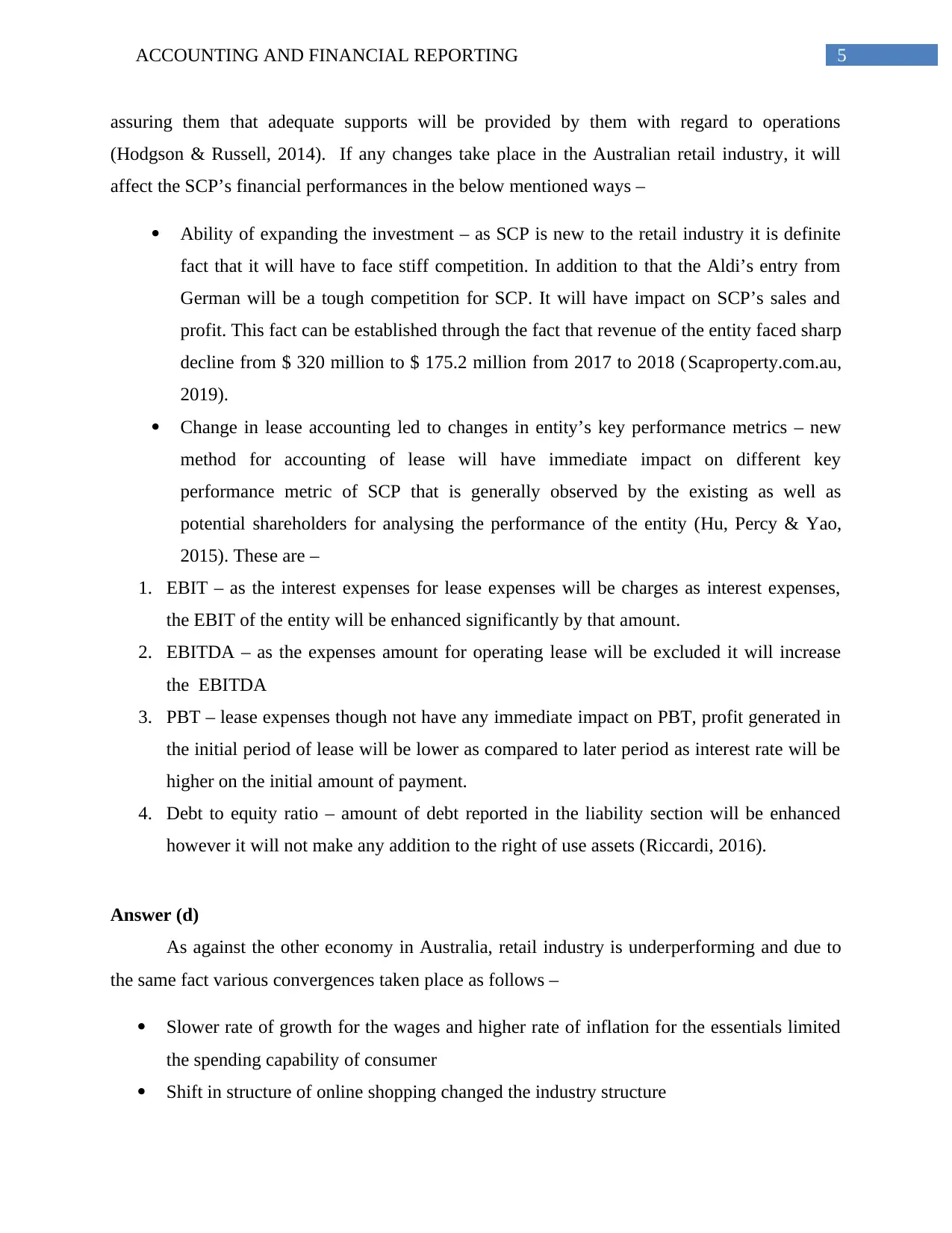
5ACCOUNTING AND FINANCIAL REPORTING
assuring them that adequate supports will be provided by them with regard to operations
(Hodgson & Russell, 2014). If any changes take place in the Australian retail industry, it will
affect the SCP’s financial performances in the below mentioned ways –
Ability of expanding the investment – as SCP is new to the retail industry it is definite
fact that it will have to face stiff competition. In addition to that the Aldi’s entry from
German will be a tough competition for SCP. It will have impact on SCP’s sales and
profit. This fact can be established through the fact that revenue of the entity faced sharp
decline from $ 320 million to $ 175.2 million from 2017 to 2018 (Scaproperty.com.au,
2019).
Change in lease accounting led to changes in entity’s key performance metrics – new
method for accounting of lease will have immediate impact on different key
performance metric of SCP that is generally observed by the existing as well as
potential shareholders for analysing the performance of the entity (Hu, Percy & Yao,
2015). These are –
1. EBIT – as the interest expenses for lease expenses will be charges as interest expenses,
the EBIT of the entity will be enhanced significantly by that amount.
2. EBITDA – as the expenses amount for operating lease will be excluded it will increase
the EBITDA
3. PBT – lease expenses though not have any immediate impact on PBT, profit generated in
the initial period of lease will be lower as compared to later period as interest rate will be
higher on the initial amount of payment.
4. Debt to equity ratio – amount of debt reported in the liability section will be enhanced
however it will not make any addition to the right of use assets (Riccardi, 2016).
Answer (d)
As against the other economy in Australia, retail industry is underperforming and due to
the same fact various convergences taken place as follows –
Slower rate of growth for the wages and higher rate of inflation for the essentials limited
the spending capability of consumer
Shift in structure of online shopping changed the industry structure
assuring them that adequate supports will be provided by them with regard to operations
(Hodgson & Russell, 2014). If any changes take place in the Australian retail industry, it will
affect the SCP’s financial performances in the below mentioned ways –
Ability of expanding the investment – as SCP is new to the retail industry it is definite
fact that it will have to face stiff competition. In addition to that the Aldi’s entry from
German will be a tough competition for SCP. It will have impact on SCP’s sales and
profit. This fact can be established through the fact that revenue of the entity faced sharp
decline from $ 320 million to $ 175.2 million from 2017 to 2018 (Scaproperty.com.au,
2019).
Change in lease accounting led to changes in entity’s key performance metrics – new
method for accounting of lease will have immediate impact on different key
performance metric of SCP that is generally observed by the existing as well as
potential shareholders for analysing the performance of the entity (Hu, Percy & Yao,
2015). These are –
1. EBIT – as the interest expenses for lease expenses will be charges as interest expenses,
the EBIT of the entity will be enhanced significantly by that amount.
2. EBITDA – as the expenses amount for operating lease will be excluded it will increase
the EBITDA
3. PBT – lease expenses though not have any immediate impact on PBT, profit generated in
the initial period of lease will be lower as compared to later period as interest rate will be
higher on the initial amount of payment.
4. Debt to equity ratio – amount of debt reported in the liability section will be enhanced
however it will not make any addition to the right of use assets (Riccardi, 2016).
Answer (d)
As against the other economy in Australia, retail industry is underperforming and due to
the same fact various convergences taken place as follows –
Slower rate of growth for the wages and higher rate of inflation for the essentials limited
the spending capability of consumer
Shift in structure of online shopping changed the industry structure
⊘ This is a preview!⊘
Do you want full access?
Subscribe today to unlock all pages.

Trusted by 1+ million students worldwide
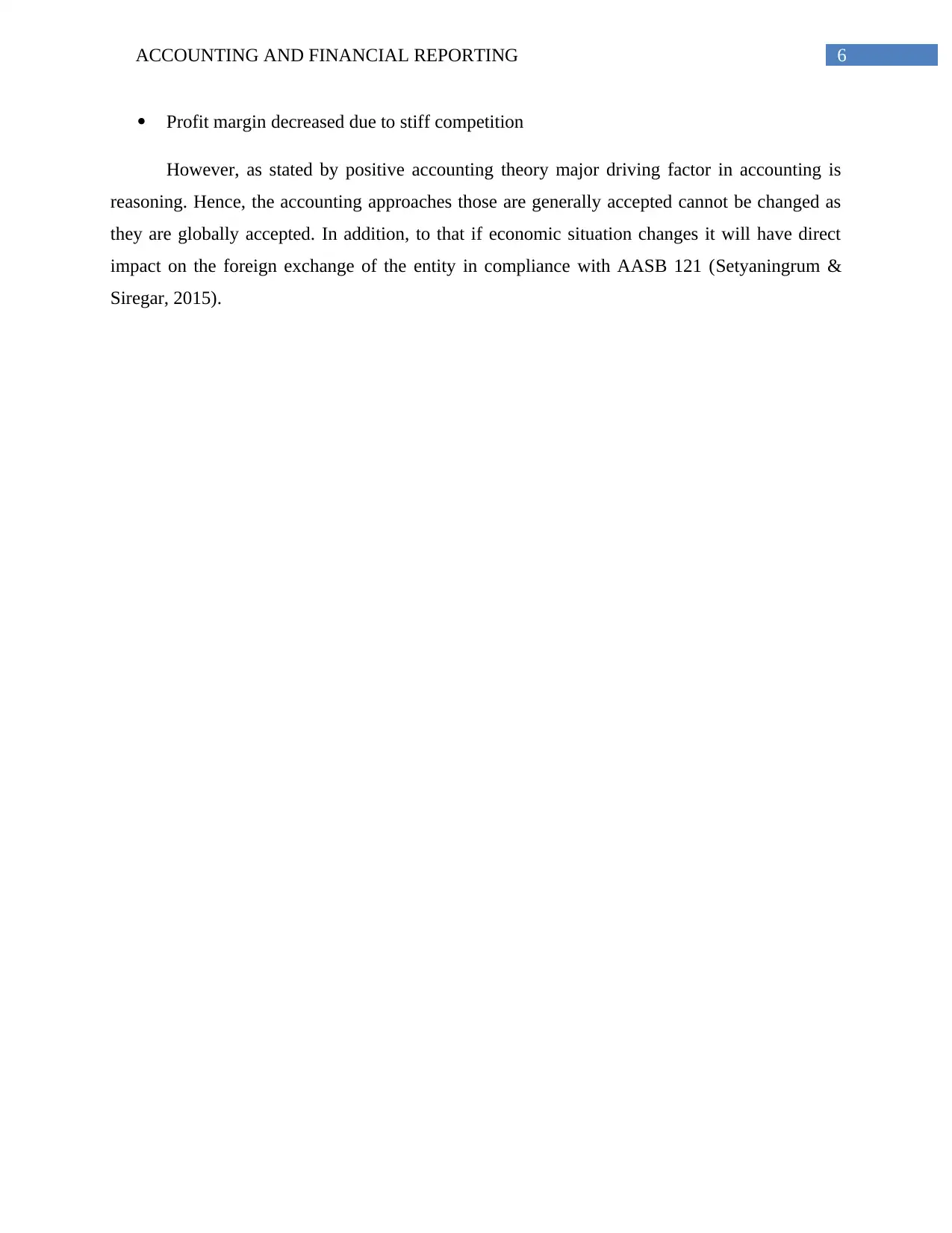
6ACCOUNTING AND FINANCIAL REPORTING
Profit margin decreased due to stiff competition
However, as stated by positive accounting theory major driving factor in accounting is
reasoning. Hence, the accounting approaches those are generally accepted cannot be changed as
they are globally accepted. In addition, to that if economic situation changes it will have direct
impact on the foreign exchange of the entity in compliance with AASB 121 (Setyaningrum &
Siregar, 2015).
Profit margin decreased due to stiff competition
However, as stated by positive accounting theory major driving factor in accounting is
reasoning. Hence, the accounting approaches those are generally accepted cannot be changed as
they are globally accepted. In addition, to that if economic situation changes it will have direct
impact on the foreign exchange of the entity in compliance with AASB 121 (Setyaningrum &
Siregar, 2015).
Paraphrase This Document
Need a fresh take? Get an instant paraphrase of this document with our AI Paraphraser
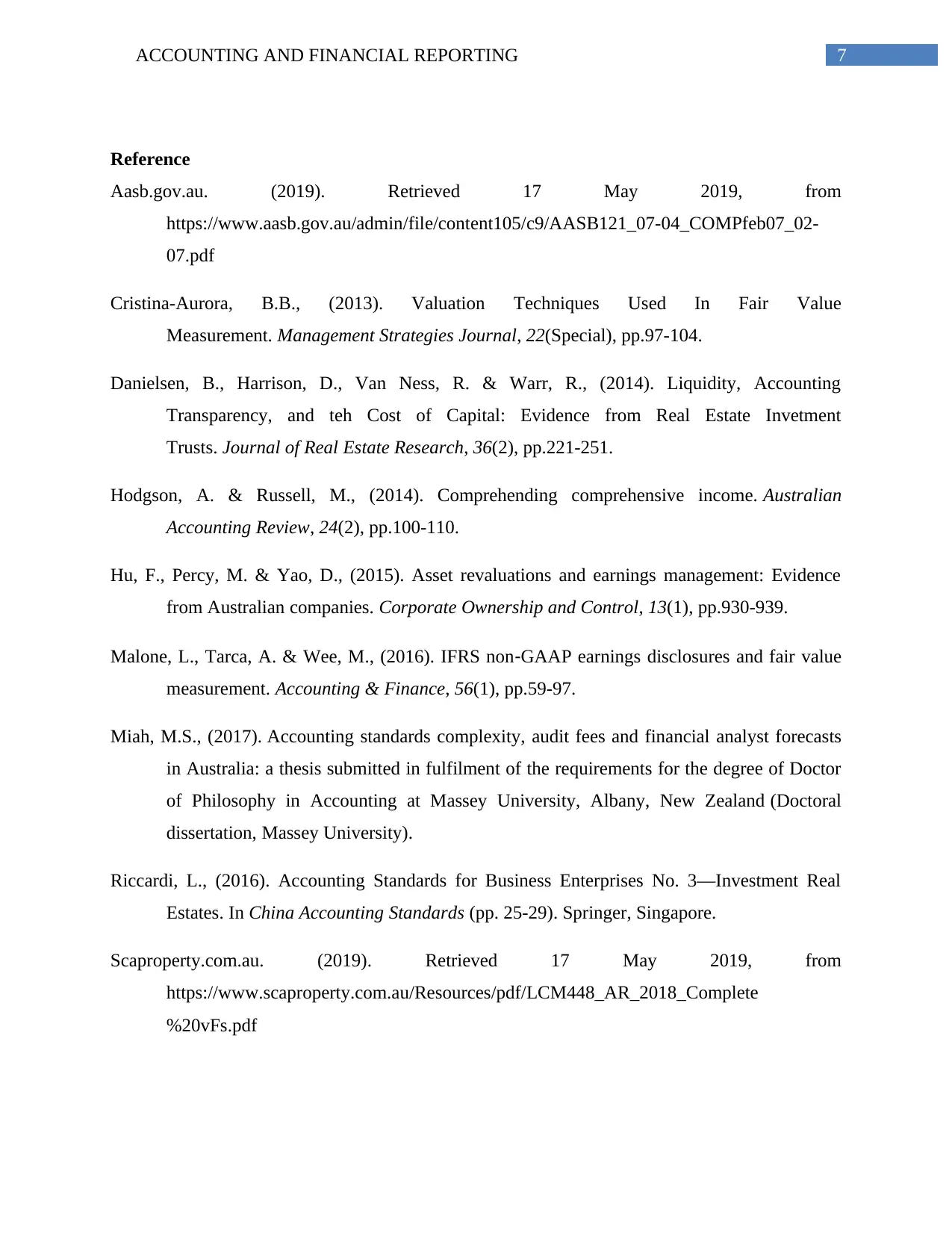
7ACCOUNTING AND FINANCIAL REPORTING
Reference
Aasb.gov.au. (2019). Retrieved 17 May 2019, from
https://www.aasb.gov.au/admin/file/content105/c9/AASB121_07-04_COMPfeb07_02-
07.pdf
Cristina-Aurora, B.B., (2013). Valuation Techniques Used In Fair Value
Measurement. Management Strategies Journal, 22(Special), pp.97-104.
Danielsen, B., Harrison, D., Van Ness, R. & Warr, R., (2014). Liquidity, Accounting
Transparency, and teh Cost of Capital: Evidence from Real Estate Invetment
Trusts. Journal of Real Estate Research, 36(2), pp.221-251.
Hodgson, A. & Russell, M., (2014). Comprehending comprehensive income. Australian
Accounting Review, 24(2), pp.100-110.
Hu, F., Percy, M. & Yao, D., (2015). Asset revaluations and earnings management: Evidence
from Australian companies. Corporate Ownership and Control, 13(1), pp.930-939.
Malone, L., Tarca, A. & Wee, M., (2016). IFRS non‐GAAP earnings disclosures and fair value
measurement. Accounting & Finance, 56(1), pp.59-97.
Miah, M.S., (2017). Accounting standards complexity, audit fees and financial analyst forecasts
in Australia: a thesis submitted in fulfilment of the requirements for the degree of Doctor
of Philosophy in Accounting at Massey University, Albany, New Zealand (Doctoral
dissertation, Massey University).
Riccardi, L., (2016). Accounting Standards for Business Enterprises No. 3—Investment Real
Estates. In China Accounting Standards (pp. 25-29). Springer, Singapore.
Scaproperty.com.au. (2019). Retrieved 17 May 2019, from
https://www.scaproperty.com.au/Resources/pdf/LCM448_AR_2018_Complete
%20vFs.pdf
Reference
Aasb.gov.au. (2019). Retrieved 17 May 2019, from
https://www.aasb.gov.au/admin/file/content105/c9/AASB121_07-04_COMPfeb07_02-
07.pdf
Cristina-Aurora, B.B., (2013). Valuation Techniques Used In Fair Value
Measurement. Management Strategies Journal, 22(Special), pp.97-104.
Danielsen, B., Harrison, D., Van Ness, R. & Warr, R., (2014). Liquidity, Accounting
Transparency, and teh Cost of Capital: Evidence from Real Estate Invetment
Trusts. Journal of Real Estate Research, 36(2), pp.221-251.
Hodgson, A. & Russell, M., (2014). Comprehending comprehensive income. Australian
Accounting Review, 24(2), pp.100-110.
Hu, F., Percy, M. & Yao, D., (2015). Asset revaluations and earnings management: Evidence
from Australian companies. Corporate Ownership and Control, 13(1), pp.930-939.
Malone, L., Tarca, A. & Wee, M., (2016). IFRS non‐GAAP earnings disclosures and fair value
measurement. Accounting & Finance, 56(1), pp.59-97.
Miah, M.S., (2017). Accounting standards complexity, audit fees and financial analyst forecasts
in Australia: a thesis submitted in fulfilment of the requirements for the degree of Doctor
of Philosophy in Accounting at Massey University, Albany, New Zealand (Doctoral
dissertation, Massey University).
Riccardi, L., (2016). Accounting Standards for Business Enterprises No. 3—Investment Real
Estates. In China Accounting Standards (pp. 25-29). Springer, Singapore.
Scaproperty.com.au. (2019). Retrieved 17 May 2019, from
https://www.scaproperty.com.au/Resources/pdf/LCM448_AR_2018_Complete
%20vFs.pdf

8ACCOUNTING AND FINANCIAL REPORTING
Setyaningrum, D. and Siregar, S.V., (2015). The Value Relevance of Foreign Translation
Adjustment: Case of Indonesia. Academy of Accounting and Financial Studies
Journal, 19(2), p.251.
Setyaningrum, D. and Siregar, S.V., (2015). The Value Relevance of Foreign Translation
Adjustment: Case of Indonesia. Academy of Accounting and Financial Studies
Journal, 19(2), p.251.
⊘ This is a preview!⊘
Do you want full access?
Subscribe today to unlock all pages.

Trusted by 1+ million students worldwide
1 out of 9
Related Documents
Your All-in-One AI-Powered Toolkit for Academic Success.
+13062052269
info@desklib.com
Available 24*7 on WhatsApp / Email
![[object Object]](/_next/static/media/star-bottom.7253800d.svg)
Unlock your academic potential
Copyright © 2020–2025 A2Z Services. All Rights Reserved. Developed and managed by ZUCOL.





